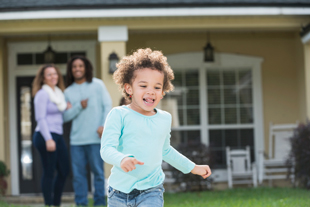"Given that most parents are unlikely to let their kids roam freely, at least not in the foreseeable future, let's ask a different question. How can we reduce risk and manage our fears while still getting our kids outdoors and giving them some meaningful autonomy?
"Here are a few strategies to consider. First the best way to get children outside is to go with them. Make family outdoor time a priority and schedule it if necessary. You may be surprised at the results. Renee Limon, a mother of two who cofounded EnviroMom.com, claims, 'When we go outside, my kids become their best selves. Gone are the petty arguments about whose turn it is to go first or what to do next. Suddenly the kids are creative, digging in the dirt, picking up worms, jumping and laughing.'
"A second strategy is to plan for outdoor time. With the crazy pace of kids' lives today, it's unlikely that they will get a reasonable amount of nature play unless you get it on the calendar. In other words, if you agree that time outdoors deserves to be an integral part of growing up, make it a priority and insert it into the weekly schedule. Let your kids know that you're doing this and explain why you think it's important.
"Given today's parental fears, if outdoor play is going to become an integral part of children's lives, most of it is likely going to have to happen in places such as backyards, schoolyards, courtyards, and parks. Fortunately, these environments can be plenty wild, especially for young children, as long as a few natural elements are added — for example, boulders, trees, sand, grasses, and perhaps a garden. The simple addition of native wildflowers attracts native insects and birds. This kind of rewilding creates a variety of miniature habitats ideally suited for engaging young minds in imaginative play.
"For kids in middle childhood, the present age focus of our discussion, try to find places that allow for more autonomy, in terms of both distance and freedom. Parents, look to local parks or other kinds of open spaces. Teachers, school grounds can make ideal places for nature play.
"Michele Whitaker offers what may be the most helpful strategy of all. Try becoming more of a 'hummingbird parent.' In her words: 'In the range from helicopter to neglect — I probably fall a bit more toward helicopter. In fact, I call myself a hummingbird parent. I tend to stay physically distant to let them explore and problem solve, but zoom in at moments when safety is an issue (which isn't very often).'
"I love the hummingbird metaphor. Whitaker suggests that grown-ups become more conscious of the physical distance they keep from kids, and take steps back as children get older to allow for increasing autonomy. Along this path, we can find potential for us to fulfill our need to keep kids safe while allowing them to take risks and push limits. If we're successful, the end result will be another generation of free-range kids.
"But here's the rub. To be most effective, nature mentoring cannot be a solo endeavor. One person may play the primary role, but children need multiple mentors."
- Go outside with children.
- Prioritize, schedule, and plan outdoor time.
- Make sure your outdoor area has some natural elements.
- Allow children the space to explore while you oversee their safety.
- Enlist other nature mentors.
